The Effects of an Enriched Elementary Arts
Education Program on Teacher Development, Artist Practices, and
Student Achievement:
Baseline Student Achievement and Teacher Data
from Six Canadian Sites
Dr. Rena Upitis
Dr. Katharine Smithrim
Ann Patteson
Margaret Meban
Queen's University
Kingston, Ontario, Canada
Abstract
Learning Through the Arts
(LTTA) is a school transformation project
developed by The Royal Conservatory of Music (Canada). The first
elementary schools were founded in Toronto, Ontario, in 1995, and
LTTA is currently operating in elementary schools in seven urban
and rural sites across Canada. LTTA is designed with the goal of
engaging students deeply in learning, through carefully designed
math, science, history, geography, and language units that
incorporate performing and visual arts into the learning process.
This goal is achieved through a structured program of teacher
development which includes the involvement of artists who work
along with teachers to develop curricula. LTTA offers effective
and sustainable professional development programs, based on the
sharing of knowledge and skills between teachers, artists, and
students, through multi-year partnerships. Artists model
techniques and activities for teachers to implement in their
classrooms and also work directly with students in schools.This
articledescribes the baseline data gathered as the first part of
the evaluation of the national LTTA program, for the students,
teachers, parents, and administrators involved in the six sites
that were established in 1999. Preliminary data were gathered
over the 1999-2000 year. Canadian Achievement Tests (CAT/3) were
used to assess students' performance in vocabulary, reading
comprehension, and mathematics. In addition, writing samples were
taken and scored holistically. Students also completed a survey
indicating their interests in schooling in general and in the
arts in particular, as well as in the activities they engaged in
outside of school. Parents were asked to report on language(s)
spoken at home, leisure activities, household income level, and
the mother's education level. Teachers were surveyed regarding a
variety of teaching beliefs and practices. Administrators were
surveyed regarding their support for arts activities, both in
terms of human and financial resources. Baseline data indicate
that there are clear correlations between achievement in
mathematics and language and engagement in arts activities,
particularly with respect to music lessons (outside of school).
That is, students who take music lessons outside of school
perform significantly better on all language and mathematics
measures than their peers who do not take music lessons. Not
surprisingly, socio-economic status is also clearly related to
arts activities and achievement, and strategies for tracking
changes within socio-economic groups over the next two years of
the study are planned. It was also found that attitudes towards
various art forms are established in students as early as the
first grade, with boys being less interested and perceiving
themselves as less skilled, for example, in singing and dancing
than their female peers. Hypotheses and general issues for
consideration for the next two years of work are described, and
methods for exploring those issues and hypotheses are also
discussed.
Context
Learning Through the Arts ä
(LTTA) is a school transformation initiative developed by The
Royal Conservatory of Music (Canada;
<http://www.rcmusic.ca/ltta/index.asp>). The first schools
were founded in Toronto, Ontario, in 1995, and LTTA is currently
operating in elementary schools in seven urban and rural sites
across Canada. A further five sites will begin in the fall of
2001, with further expansions planned for subsequent years. By
2003, it is expected that 100,000 students will be taking part in
the LTTA program in Canada, expanding to the middle school and
high school settings as well.
LTTA is designed with the goal of
engaging students deeply in learning, through carefully designed
math, science, history, geography, and language units that
incorporate performing and visual arts into the learning process.
This goal is achieved through a structured program of teacher
development which includes the involvement of artists who work
along with teachers to develop curricula. LTTA offers effective
and sustainable professional development programs, based on the
sharing of knowledge and skills between teachers, artists, and
students, through multi-year partnerships. Artists model
techniques and activities for teachers to implement in their
classrooms and also work directly with students in schools. Early
research on the LTTA program, conducted in the pilot schools from
1995-1999, was based on interview data, journals, and participant
observations. This research indicated that students were engaged
by the LTTA program, achievement on language and mathematics
measures increased, teachers reported positive changes to their
teaching practices and attitudes towards the arts, and
administrative practices were changed to increase support for
arts curricula after involvement with the program (Elster &
Bell, 1999; Wilkinson, 1996, 1998).
In the
summer of 1999, a comprehensive design for evaluating the
national LTTA elementary school sites was planned. The design was
developed during a two-day retreat, with researchers and school
board representatives from Vancouver (The University of British
Columbia), Calgary, Regina, Windsor (University of Windsor),
Kingston (Queen's University), Cape Breton, and Corner Brook
(Memorial University of Newfoundland). The design includes the
use of standardized instruments and a number of other
quantitative measures for all three years of the study, as well
as qualitative measures for years 2 and 3 of the study, to
illustrate and illuminate the quantitative findings. Canadian Achievement Tests (CAT/3) were used to assess
students' performance in vocabulary, reading comprehension, and
mathematics. In addition, writing samples were taken and scored
holistically. Students also completed a survey indicating their
interests in schooling in general and in the arts in particular,
as well as in the activities they engaged in outside of school.
Parents were asked to report on language(s) spoken at home,
leisure activities, household income level, and the mother's
education level. Teachers were surveyed regarding a variety of
teaching beliefs and practices. Finally, administrators were
surveyed regarding their support for arts activities, both in
terms of human and financial resources. The instruments are
discussed in greater detail later in the paper.
This article describes the
baseline data gathered to evaluate the effects of the LTTA
program, for the students, teachers, parents, and administrators
involved in the six Canadian sites. These six sites were
established in 1999, and preliminary data were gathered over the
1999-2000 year.
Related
Literature
In the
years between 1950 and 1980, arts education proceeded under the
mantle of the aesthetic education movement (Reimer, 1970). During
this period, arts education was justified by solely aesthetic or
intrinsic endsóart for art's sakeóand not, for
example, to enhance self-esteem or improve reading skills. To
conduct research on the non-arts effects of arts education was
"out of vogue at best, out of touch at worst" (Cutietta, Hamann,
& Walker, 1995, p. 5). Consequently, little research on the
non-arts outcomes of arts education took place in North America
in those decades. In the early 1970s, Eisner (1974) began calling
for the evaluation of the educational impact of arts programs. He
suggested that special arts programs in schools should be
evaluated "because it is important to know what educational
impact arts initiatives have, and...when public money funds
programs, there is an obligation to determine...whether the
programs are effective" (p. 21). Consequently, in the following
decades many arts programs were evaluated, and there is now a
growing body of evidence showing that arts education affects
other aspects of life and learning beyond the value of the arts
experiences themselves.
Reported benefits of
arts education include the development of the imagination
(Greene, 1995), the elevation of students' intrinsic motivation
to learn (Csikszentmihalyi, 1997), the improvement of children's
spatial reasoning abilities (Rauscher, Shaw, Levine, Wright,
Dennis, & Newcomb, 1997), and the development of higher
levels of self-esteem (Sylwester, 1998). Recent American studies
report increased academic achievement for students involved in
the arts (Catterall, 1998; Catterall, Chapleau, & Iwanaga,
1999; Hamblen, 1993; Luftig, 1994; Moore & Caldwell, 1993;
Murfee, 1995; Music in World Cultures, 1996; Welch & Greene,
1995). However, as Eisner points out, "although there is much
material published that claims the arts cause academic
achievement scores to increase...it is often difficult to know
the basis upon which the claims are made" (1998, p. 8). Indeed,
Winner and Hetland (2000) conducted an
extensive analysis of the body of research that purports a
positive relationship between the arts and academic achievement
and concluded that claims are being made that are, by and large,
based on unsubstantiated research findings. They stress the need
for more rigorously designed, theory-driven, quasi-experimental
research with appropriate comparison groups, and also encourage
researchers to investigate how school environments that are rich
in the arts impact on students' motivation, engagement, and
understanding. Although Winner and Hetland warn against
justifying the arts solely by non-arts outcomes, they argue that
there is a clear need for more rigorous research that addresses
the link between the arts and academic achievement, as
this type of research hasimportant
implications for education and cognitive science.
Although much of the
previous research has failed to take socio-economic status into
consideration, one report by Catterall, Chapleau and Iwanaga
(1999), cited in the Champions of Change initiative of the U.S.
Secretary of Education, addresses this important issue
(http://www.aep-arts.org/highlights/coc-release.html).
The researchers analyzed differences in achievement and attitude
for 25,000 students over a ten year period, treating students who
were disadvantaged in terms of socio-economic status (SES) as a
separate group. For all students, but particularly for those in
the low SES group, academic performance, attitudes and behavior
were all positively affected by high arts involvement. Catterall
et al. also found that the probability of being highly involved
in the arts is twice as high for economically advantaged
students.
The research described
in the present article responds to the challenges of Winner and
Hetland and complements and extends the work of Catterall et al.
(1999). Because the experimental (LTTA) schools are being
compared to two types of control schools (schools initiating
other special programs and schools with no special programs),
evidence of connections between arts education and achievement
may be more clearly determined through this research program.
Like the work of Catterall et al., the research design also takes
into account the effects of socio-economic status.
Teacher transformation
is another expected outcome of the professional development
program, as one of the foci of the program is that of
professional development for teachers
<<http://educ.queensu.ca/~arts>>. In an earlier
study, using a different model for enhancing arts education and
teacher development in elementary schools, Upitis, Smithrim, and
Soren (1999) concluded that profound changes to teachers'
practices and beliefs arose when teachers worked directly with
artists and experienced the artistic process while making their
own art, and that lasting and profound changes occurred for a
number of participants (20%) after two years of professional
development. Among the benefits teachers ascribed to the program
were confidence to try new things, a new appreciation of the
planning and work involved in art-making, a revitalization of
teaching in other subject areas, and a commitment to provide more
time, materials, instruction and support for students'
art-making. Data were analyzed using a three-level matrix
developed by Upitis, Smithrim, and Soren (1999) to assess and
describe teacher transformation. The first level of the matrix
identified conditions that were necessary, but not sufficient,
for teacher transformation (e.g., exploration of new art forms
and media). The second level identified the potential for
sustained transformation (e.g., changing images of artists). The
third level identified ways in which profound changes were
operationalized (e.g., long-term pursuits of new art
forms).
Research
Questions
The research is guided
by three major questions, with a number of related sub-questions.
They are as follows:
- Do the students involved
in LTTA schools take more interest in learning in general, and in
the arts in particular, than do students in the two types of
control schools? Are there differences in student attitudes and
achievement that can be accounted for by program effects, in
addition to the differences explained by socio-economic
status
- Do the teachers who take
part in the LTTA schools become more involved in the arts, and
value the arts in more ways, than teachers in other schools, as
indicated by reported changes in their personal lives and
classroom practices?
- Do the principals and
superintendents of the participating LLTA schools allocate more
human and financial resources to the arts, and make changes to
the school environment, as a result of the LTTA
program?
Sub-Questions
The research is further
guided by sub-questions including, but not limited, to the
following:
-
Students
- Does participation in the LTTA program improve
students' attitudes toward learning and schooling?
- Does
participation in the LTTA program improve students' attitudes
toward the arts?
Does participation in the LTTA
program improve student achievement in mathematics and
language?
Are changes in achievement in
mathematics and language independent of socioeconomic status
(SES)? If not, how does SES affect the achievement/arts
interaction effects?
Do children who take part in the
LTTA program increase the time they spend on the arts outside of
school?
Are other student habits and
values affected by the LTTA program (e.g., reading for pleasure,
participation in sports, watching television)?
Are gains associated with the
LTTA program also found for students who attend schools with
other specialized programs (e.g., technology
programs)?
How do changes in LTTA schools, over a three
year period, compare with "regular" schools (i.e., those without
special school-wide initiatives)?
Teachers
- Do teachers' beliefs and practices, as related
to the curriculum in general, change as a result of the LTTA
program?
- Do teachers begin to value the arts more as a
result of the LTTA program?
- Do teachers devote more class time to learning
through the arts as a result of the LTTA
program?
- Do teachers devote more class time to learning
in the arts as a result of the LTTA program?
- Do teachers change their art-making and
art-viewing life habits as a result of the LTTA
program?
- Do teachers' images of artists change as a
result of the LTTA program?
Parents
- Do parents invest in more arts-related
activities outside of school as a result of the LTTA
program?
- How do such investments compare across
household income groups?
Administrators
- Do principals devote more human and financial
resources to the arts as a result of the LTTA program?
- Do principals make changes in the school
environment and school structures and practices as a result of
the LTTA program?
- Do school district administrators devote more
human and financial resources to the arts as a result of the LTTA
program?
- Do school district administrators shift funding
priorities as a result of the LTTA program?
Data Collection and
Analysis
The research involves the
collection and analysis of data in LTTA schools in Vancouver,
Calgary, Regina, Windsor, Cape Breton, and Corner Brook. As noted
previously, two types of control schools are involved in each of
the six sites: schools with a special school-wide initiative
(such as an emphasis on technology), and schools without any
particular school-wide initiative (called "regular"
schools).
Learning Through the
Arts ™ (LTTA) programming was
introduced with a staggered entry by grade. In the first year of
programming (1999–2000), students in Grades 1 and 4 were
involved. In the second year (2000–2001), students in
Grades 1, 2, 4, and 5 took part. In the final year
(2001–2002), all six elementary grades (Grades 1 through 6)
will take part in the LTTA program. The data were collected with
a similar staggered entry. Approximately 900 students were
sampled in each grade (600 LTTA, 150 special initiative, 150
regular), and all of the teachers and principals in the LTTA
schools and the two types of control schools were invited to take
part in the research (the response rate, thus far, has been over
80%). The two control conditions were matched as closely as
possible to the LTTA schools in other dimensions (e.g.,
socio-economic status of the students and their families, and
size of school).
The student measures,
administered at regular intervals throughout the three year
study, included the following:
1) Standardized scores on
achievement tests (CAT/3) for reading comprehension, vocabulary,
and mathematics,
2) Writing samples (scored
holistically), and
3) Survey questions dealing with out
of school activities (e.g., music lessons, sports, television
viewing, reading for pleasure, computer and videogame play),
interest in school and school subjects, and interest in and
attitudes towards the arts.
Parents of
the students were also surveyed on a number of dimensions,
including mother's education level, household income, leisure
activities, and language(s) spoken in the home. Parents are
surveyed twice, at the beginning and end of the study.
Because teachers are the
primary agents of change in schools, research on teacher
knowledge and teacher transformation informs not only the
rationale but also contributes to the methodology for the
research. Schˆn (1991) argued that the connections between
research and practice have to be addressed directly within
research; teachers' developing knowledge and practice are at the
heart of this research. Whereas the focus of teacher education
and development used to be on teacher performance and improving
performance through behaviorist notions of change or on changes
in school curricula, the focus has shifted towards teacher
knowledge about teaching and how it is acquired (Bresler, 1993).
Central to the research methodology is the conviction that
teachers change their practice as they gain new knowledge and
experience, within the "macro" contexts in which they find
themselves (Bresler, 1998). Thus, we examine how teachers'
practices change as their knowledge changes through the infusion
of the perspective of artists, rather than how practices change
in response to imposed curriculum guidelines. These changes are
documented and analyzed through the use of teacher surveys,
administered regularly throughout the study, and interviews with
a purposefully selected sample of teachers. Changes in
administrators' beliefs and practices are documented and analyzed
in a similar fashion.
Summary of Findings:
Year One Baseline Data
This article describes the
baseline findings that were determined from Year 1 of the study
(1999-2000). At the time of writing the present paper, data were
being gathered and analyzed for Year 2. Accordingly, comparisons
between types of schools and changes in students', teachers', and
administrators' beliefs and practices will be made in the next
report on the LTTA study.
Even with baseline data
alone, some interesting correlations can be reported. It must be
borne in mind, however, that these are correlations that already
existed between and amongst the variables as the programs began
to be implemented.
Correlations are
examined between gender and other variables, among the three
conditions (experimental [LTTA] and two types of control schools
[special initiative and regular]); and from factors in the
students' backgrounds (e.g., socio-economic status and previous
arts experiences).
Baseline
Comparisons Between LTTA, Special Initiative, and Regular
Schools
For almost all measures,
there were no significant differences between students, teachers,
principals, and parents in LTTA, special initiative, and regular
schools. This is an important finding, as it will allow for
meaningful comparisons between the three types of schools in
Years 2 and 3 of the study. In particular, there were no
differences between students in terms of achievement in
mathematics and language, and in terms of out of school
activities.
Student Achievement, Socio-economic Status, and
the Arts
The single
greatest predictor of academic achievement was socio-economic
status (as indicated by household income as well as by mother's
education level). That being said, of the various art forms,
those students who took music lessons outside of school scored
significantly better on all language and mathematics measures
than their peers (p<.05). It must be stressed, however, that
these are merely correlations, that is, cause and effect cannot
be implied from the correlations alone.
Student Desires, Beliefs, and Practices and the
Arts
Grade 1
students. Most Grade 1 children, in all
three types of schools, reported that they felt "happy" when
engaged in a number of arts activities. Some of their responses
are summarized in Table 1, in descending order of enjoyment
(rounded to the nearest percentage, with aggregate means across
schools reported).
Grade 4
students. A summary of free time
preferences for out of school activities for Grade 4 students
appears in Table 2 below. The percentages represent the average
responses, across types of schools, of students who "strongly
agree" with the statement that they like to take part in the
named activity.
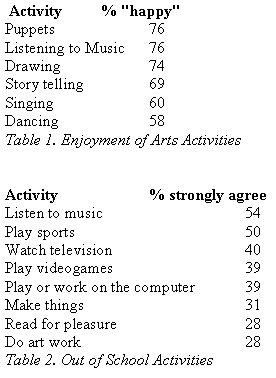
The following two tables
(Tables 3 and 4) report the average percentage, across school
types, of Grade 4 students who take lessons or perform as
indicated.
Attendance at
performances and exhibitions by Grade 4 students is indicated in
the following table, where the average percentage of students
responding "strongly agree" to each type of activity is
reported.
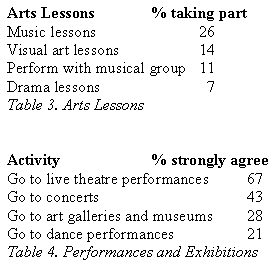
The average percentages
of Grade 4 students attending more than one performance per year
in each of the categories are shown in Table 5.
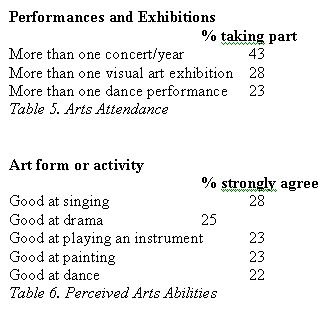
Grade 4
students perceptions of themselves in terms of
abilities in the arts are described in Table 6.
A summary of attitudes
towards school and arts subjects, for the Grade 4 students,
appears below.
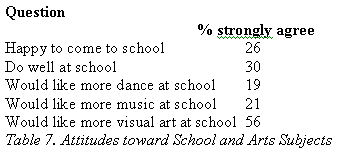
The only place where significant differences between
students in the LTTA schools and the other types of schools were
found were with respect to some of the questions related to the
arts as subjects. Students in LTTA schools were, generally
speaking, more interested in the arts subjects. This may be due
to the fact that some LTTA programming had already taken place by
the time the baseline measures were taken in the 1999-2000 school
year. Differences between students in the three types of schools
appear below. In all cases, p < .05.

Gender Differences:
Grade 1.There were strong differences
by gender in student preferences. These were apparent as early as
Grade 1. Each of the following differences reported is
statistically significant at p<.05.
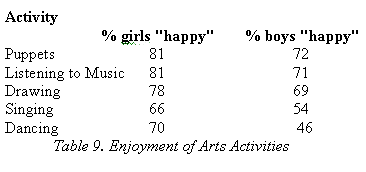
Gender Differences:
Grade 4. Grade 4 students also differed
by gender regarding preferences for arts activities, and also on
their perceived skills in various art forms. Some of the
significant findings appear below; in each case,
p<.05.
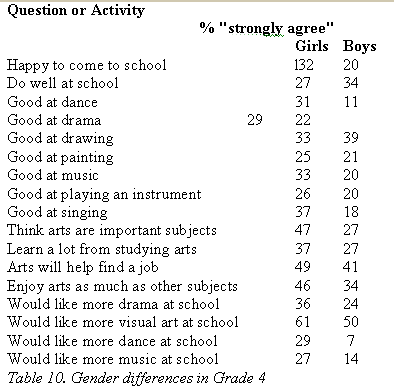
Significant gender
differences for out of school activities are shown
below:
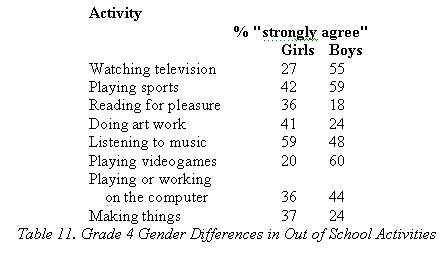
Music Lessons and
Other Out-of-School Activities.Of the
26% of the students in Grade 4 who took music lessons outside of
school, most were girls. One in every three girls and one in very
five boys reported taking music lessons. There were also
significantly more girls taking dance lessons (21%) than boys
(5%). Those students engaged in music lessons were less likely to
watch television or play videogames than their peers, and more
likely to read for pleasure. Similar significant results were
found for dance lessons.
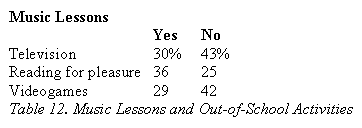
Parents and the Arts
Approximately 55% of the
parents filled in the optional survey item regarding household
income, while almost 70% indicated mother's level of education.
Of the sampled households, 36% of the mothers had achieved a high
school education, 51% had a university or college education, and
13% had completed post-graduate studies.
Adults who valued arts
activities, as indicated by their own leisure choices, were more
likely to have children who took music lessons outside of school
(p< .05). The percentages of parents who reported taking part
in the various leisure activities appear in the following
table:
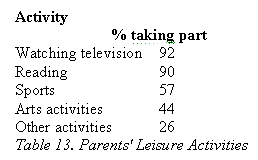
Teachers' Beliefs and Practices and the
Arts
Teachers (in all types
of schools) believe in the value of the arts. Indeed, 98.7% of
the teachers either "strongly agree" or "agree" that the arts are
fundamental to quality learning. Despite their belief in the
importance of the arts, fewer than half of the teachers (41%)
either "agree" or "strongly agree" with the statement, "I try to
schedule arts every day for at least an hour". This indicates
that teachers' beliefs and practices do not always
coincide.
Most teachers (98.7%)
believe that students can express knowledge and skills through
the arts. Nevertheless, only 18.5% of the teachers frequently use
the arts as a teaching tool, and one in three teachers often
schedules arts at the end of the day or the week.
Close to 80% of the
teachers feel that the arts are an effective way of increasing
parental involvement in the classroom, while close to 90% of the
teachers agree that the arts are an effective way to reach the
"hard-to-educate" student. Most teachers (93%) do not believe
that bringing artists into the classroom is
disruptive.
Of the teachers in all
three types of schools, 6.6% strongly agreed with the
statement "I am involved in the arts as an artist," with a
further 28% agreeing with the statement. Of this group,
most were involved in the visual arts (16%), with the next most
common art form being music (11%), followed by drama (7%), and
dance (6%).
Teachers' attendance at
performances and exhibitions can be summarized as
follows:

Administrators' Beliefs and Practices and the
Arts
Reported administrator
practices at the school board or district level were often those
that were mandated by the Departments and Ministries of
Education. This applied to issues such as core programs,
compulsory arts credits, and hours of instruction. In many cases,
staff support was an issue identified as something led by
principals, as was staff development and community attitudes
towards the arts. Resources devoted to the arts varied widely
across the country.
The main impediment to
creating stronger arts programs in schools, as identified by
board administrators, was that of leadership at the school,
community, and district levels. Leadership factors included
principals' leadership, consultants' support, teacher interest,
and home and school association support. The lack of trained
teachers in the arts was also identified as an impediment. Human
resource issues were considered more of an issue than financial
or curriculum resources.
All districts followed
provincial curriculum guidelinesómusic and art are
required in elementary schools in all districts surveyed. Drama
and dance are required in three-quarters of the districts.
However, board respondents indicated very little provincial
support in terms of consultative staff and there are few district
consultants available leaving the classroom teachers very much on
their own to implement curricula which in some cases can be quite
demanding (e.g., the new Ontario Arts curriculum).
Years Two and
Three
Several hypotheses are
being examined in years two and three of the program. Based on
our preliminary findings and an examination of related research,
we expect to find the following for students:
- Students in the LTTA program will become more
engaged in learning and demonstrate improved academic achievement
over the three years of the study than their peers in the control
conditions, as a result of the effects of learning through the
arts.
- Students who take music lessons outside of
school will continue to perform better on math and language than
students who engage in other arts activities. Further, growth in
the number of children taking music lessons may occur in the LTTA
students over the two control conditions.
- Participation in arts activities by students
will be continue to be correlated positively to mother's
education level and household income.
- Time spent watching television and playing
video games will be continue to be negatively correlated with
arts activities outside of school and with math and language
achievement.
- Socio-economic status will continue to account
for most of the variance in achievement in mathematics and
language, followed by children's activities out of school,
namely, music lessons, reading for pleasure, and engagement in
sports activities.
- From an early age, girls will like to sing and
dance more than boys, and girls will consider themselves more
skilled than boys in singing and dancing. Over time, however,
these gender differences will diminish in the LTTA
schools.
- Students who engage in arts activities outside
of school will continue to be more likely to read for pleasure
and spend less time watching television and playing video games
than their peers.
Answers to the major
research questions and sub-questions listed in the previous
section, will also be sought, as related to changes in teachers'
and administrators' beliefs and practices. In addition, several
other questions will be addressed in Years 2 and 3. Of these, one
of the most crucial will be to test the emerging hypotheses
against another large-scale Canadian study called the
National Longitudinal study on Children and Youth (NLSCY), which
was initiated in 1994 by Statistics Canada and involves 15,000
students and their teachers and families. The NLSCY study
includes student data on many of the same issues considered in
the present study (e.g., out of school activities including the
arts, sports, reading, television, computer and videogames), as
well as information on such items as friendships, bullying, and
substance abuse, which are beyond the scope of the present study.
However, it is possible to both verify the representativeness of
the LTTA sample against the NLSCY sample as well as to extend the
findings of the LTTA data through the NLSCY database.
Arrangements have been made with analysts at Statistics Canada to
do just this during Years 2 and 3 of the study.
Another question that
will be addressed more fully in Years 2 and 3 is that of the
relative effects of socio-economic status. Following the
example of Catterall, Chapleau, and Iwanaga (1999), the
researchers will attempt to determine the relative value of the
experimental programs across income groups, as indicated by
changes in student achievement, attitudes, beliefs, and
practices.
Yet another issue to be
addressed in Years 2 and 3, and this is more of a theoretical
rather than an empirical issue, is the question: What makes music special?
It would appear from a preliminary analysis of the Year 1
findings, as well as from the Catterall et al. (1999) study, that
music affects performance in mathematics and language to a
greater extent than the other art forms. An attempt to begin to
delineate the cognitive roots of music and mathematics and
language that would explain this finding will be made, on the
basis of the research literature and follow-up interviews with a
sample of the students. The non-cognitive aspects of music, such
as the self-discipline required to pursue lessons, will also be
considered.
The
findings related to gender will also be examined further
in Years 2 and 3. Some of the gender trends are strong ones;
interviews will be employed to assess some of the reasons that
students and teachers both attribute as causes for these
differences.
Information regarding the nature of the
various art forms and activities in which both children and
adults take part will also be considered in subsequent
years.
Finally,transformations to teaching
practices, artistic practices, and school culture will be
assessed through survey data and the transformation matrix
developed previously (Upitis, Smithrim, & Soren, 1999).
Reasons for such transformations will be sought through
semi-structured interviews in Year 3.
Concluding
Comments
The arts are important
to human development and to the social and economic health of our
nations (Pitman, 1998; Schacter, 1996). Because of the demonstrated importance of the arts and
the lack of emphasis both on arts education and research, this
research is important because it will shed light on how the arts
can be infused in elementary schools, not just in those few
schools where the teachers and administrators are specially
selected for their commitment to the arts. This new knowledge
will help administrators, teachers, and policy makers, select and
implement effective arts programs for their
schools.
This
research is also significant in that there has never been an
evaluation of an arts initiative of this scale in Canada, in
which teacher and student transformations and changes in
administrative practices are documented and analyzed. Over time,
the student achievement component will provide important insights
regarding the effects of arts education on academic achievement.
Most important of all, the study promises to provide a
comprehensive description of student life, both within and
outside the school, and how students' lives are affected by the
arts, and how teachers and administrators contribute to the
students' development while at the same time, altering their own
personal and professional beliefs and practices to more fully
embrace the arts.
Acknowledgments
The authors of this
article gratefully acknowledge the assistance provided by Angela
Elster, Director of Learning Through the Arts™;
members of the national research team: Sandra Falconer Pace, Rita
Irwin, Kit Grauer, Marg Guillet, Eric Favaro, Cathy MacNeil, and
Catherine Jordan; and graduate students: Alex de Cosson, Margaret
Meban, Ann Patteson, Alison Pryer, Stephanie Springgay, Sylvia
Wilson, and Lee Vogel. The authors also acknowledge the support
of the Social Sciences and Humanities Research Council of Canada,
and the following groups and institutions for their support for
the national assessment: Learning Through the Arts™,
Royal Conservatory of Music, the Toronto Dominion Financial
Group, Canada 2000, Salamander Foundation, CP Charitable
Foundation, the Government of Ontario, and the George Cedric
Metcalf Foundation.
This research was originally reported
at the American Educational Research Association Annual
Meeting, Seattle, Washington, April 10-14, 2001.
A similar
version of this paper was also presented at the 2nd International
Conference for Research in Music Education, School of Education,
University of Exeter, April 3-7, 2001, and will be presented at
the Canadian Society for the Study of Education (CSSE),
University of Laval, QuÈbec City, May 23-27,
2001.
The
research reported here was supported, in part, by the Social
Sciences and Humanities Research Council of Canada (Grant
#410-2000-0052)
References
Bresler,
L. (1993). Teacher knowledge in music education research. Council
for Research in Music Education, 118, 1-20.
Bresler, L. (1998). The
genre of school music and its shaping by meso, micro, and macro
contexts. Research Studies in Music Education, 11,
2-18.
Catterall, J. (1998).
Does experience in the arts boost academic achievement? Art
Education, 51(3), 6-11.
Catterall, J., Chapleau,
R., & Iwanaga, J. (1999). Involvement in the Arts and
Human Development: General Involvement and Intensive Involvement
in Music and Theater Arts. The Imagination Project at UCLA
Graduate School of Education and Information Studies, University
of California at Los Angeles.
<http:www.aep-arts.org/highlights/coc-release.html>
Cutietta, R., Hamann,
D., & Walker, L.M. (1995). Spinoffs: the extra-musical
advantages of a Musical Education. Elkjart, IN: United
Musical Instruments.
Csikszentmihalyi, M.
(1997). Assessing aesthetic education. Grantmakers in the
Arts, 8(1), 22-26.
Eisner, E.W. (1974). Is
the artists-in-the-schools program effective? Art Education,
27(2), 19-23.
Eisner, E.W. (1998).
Does experience in the arts boost academic achievement? Art
Education, 51(1), 7-15.
Elster, A.
& Bell, N. (1999). Learning Through the Arts: A partnership
in educational transformation. In B. Hanley (Ed.). Leadership,
Advocacy, Communication: A Vision for Arts Education in
Canada (pp. 145-154). Victoria: Canadian Music Educators
Association.
Greene, M. (1995).
Releasing the imagination: Essays on education, the arts, and
social change. New York: Teachers College Press.
Hamblen, K. A. (1993).
Theories and research that support art instruction for
instrumental outcomes. Theory into Practice, 32 (4),
191-198.
Luftig, R. (1994).
The schooled mind: Do the arts make a difference? Year 2.
Oxford, OH: Center for Human Development, Learning, and Teaching,
Miami University.
Moore, B. &
Caldwell, H. (1993). Drama and drawing for narrative writing in
the primary grades. Journal of Educational Research,
87(2), 100-110.
Murfee, E. (1995).
Eloquent evidence: Arts at the core of learning.
Washington, DC: President's Committee on the Arts and
Humanities.
Music in World Cultures
(1996). The Georgia project: A Status report on Arts Education in
the State of Georgia. St. Bonafice, MN: Author.
Pitman, W. (1998).
Learning the Arts in an age of uncertainty. Toronto: Arts
Education Council of Ontario.
Rauscher, F. H., Shaw,
G. L., Levine, L. J., Wright, E. L., Dennis, W. R., &
Newcomb, R. L. (1997). Music training causes long-term
enhancement of preschool children's spatial-temporal reasoning.
Neurological Research, 19, 2-8.
Reimer, B. (1970). A
Philosophy of Music Education. Englewood Cliffs, NJ:
Prentice-Hall.
Schacter, J. (1996).
Parents for Music Education, The Artspaper, 6 (3),
2.
Schon, D.
(1991). The reflective turn: Case studies in and on
educational practice. New York: Teachers College
Press.
Sylwester, R. (1998).
Art for brain's sake. Educational Leadership, 56(3),
31-35.
Upitis, R., Smithrim,
K., & Soren, B. (1999). When teachers become musicians and
artists: Teacher transformation and professional development.
Music Education Research, 1(19), 23-35.
Welch, N. & Greene,
A. (1995). Schools, communities and the arts: A research
compendium. Tempe, AZ: Morrison Institute for Public Policy,
Arizona State University.
Wilkinson, J. A. (1996).
Literacy, education and arts partnership: Assessing principles
and processes effecting a community-system level initiative to
integrate the arts across the curriculum: Executive summary.
Toronto: OISE and The Royal Conservatory of Music.
Wilkinson, J. A. (1998).
Learning through the arts assessment (interim report).
Unpublished manuscript, available from the Royal Conservatory of
Music, Toronto.
Winner, E. &
Hetland, L. (2000). The arts and academic improvement: What the
evidence shows: Executive summary. Journal of Aesthetic
Education, University of Illinois Press, Fall
2000.
About the Authors
Dr. Rena Upitis
Faculty of
Education
Queen's
University
Kingston,
Ontario
Canada
Telephone:
(613) 533-6212
Fax (613)
533-6761
E-mail: upitisr@educ.queensu.ca
Rena Upitis is the
former Dean of Education at Queen's University, and currently a
Professor of Education at Queen's. A musician and
composer,
Dr. Upitis has worked as
a music teacher in inner-city schools in Canada
and the United States
and her two books on music teaching explore
possibilities for
teaching music through children's improvisation and
composition in regular
classroom settings. She is also co-author of a
book on elementary
mathematics teaching. Her various research projects
have explored teacher
transformation through the arts and the use of
electronic games in
mathematics and science education.
Katharine Smithrim (PhD,
Eastman) is Associate Professor of Education at
the Faculty of Education
at Queen's University, Kingston, where she
teaches music in the
pre-service programme and courses in arts education
at the graduate level.
Her current research interests are music in early
childhood, teacher
transformation through the arts and the spiritual
dimension in teaching
and learning. To keep her grounded in the real world,
she continues to perform
as a singer and to teach preschoolers. She is
co-author of The Arts as
Meaning Makers (2001, Pearson).Along with Bob
McGrath of Sesame
Street, she has made two commercial recordings: "The
Baby
Record" and "Songs and
Games for Toddlers," the latter a Juno nominee and now
a Golden Book
Video.
Ann Patteson is
performing artist and a Ph.D. student at the Faculty
of
Education, Queen's
University, Kingston, ON. Her research is focussed on
teachers' personal
renewal and professional transformation through the
arts.
Margaret Meban is a
Ph.D. student at Queen's University, Kingston, ON. Her
research interests
include visual arts education and contemporary
artistic
practice.
|











